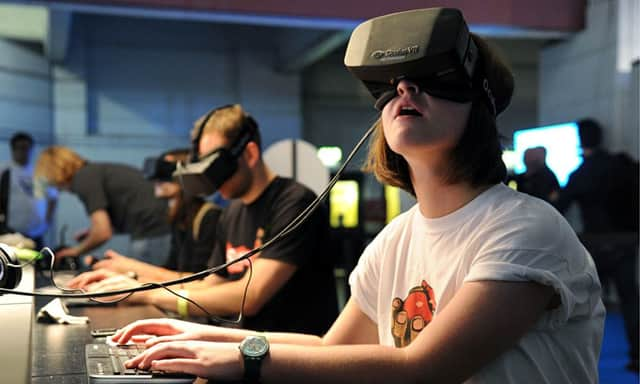How Oculus Rift will transform the way we consume video games, music and movies


It may seem like something only hinted at in the sci-fi movies of the past, but now gamers and internet users will be able to physically interact with another world from the comfort of an armchair.
With the first Kickstarter-funded orders being delivered late in March, industry critics have had their first taste of the final version of the product. How might Oculus Rift change the way we consume entertainment?
GAMING
Advertisement
Hide AdFor Eugene Chung, Head of Film and Media at Oculus, “the things that are going to be really revolutionary in VR are the things we can’t even imagine today.”
As many have predicted, it’s the device’s immersive gaming capability that will radicalise how people interact with their games. Familiar sports games such as VR Tennis or Project CARS are available from launch, with the vast majority of Day One-playable content sticking to a third-person approach. But there are also titles and demos that put you in the heart of the action, with the possibility of seeing your friends die in first-person shooters a potentially troubling part of the gaming world seen in shooters such as EVE Valkyrie.
Another Rift-specific demo places the player at a cliff’s edge, with users reporting that they’ve involuntarily frozen their knees in place as their brain thinks they could fall, such is the realism.
A spokesperson for Oculus has confirmed that the Oculus Store will be receiving monthly content updates in time, which sounds like an echo of the sentiment that has kept VR fans waiting since 2012 to try what may well be 2016’s hottest tech device. For now though, there are around 30 games to play on the £420 system.
The majority of the VR illusion comes from the impressive 1200 x 1080 pixel resolution per eye display, with a 90Hz picture refresh rate akin to that of a Full HD television set from its AMOLED screens. From the moment you load Oculus Home, the home screen that mimics a living room complete with carpet and books, the user can gesture to select the interactive content they want to play, purchase or watch, making the most of VR at each opportunity.
MUSIC
While the first Rifts are shipping with Xbox One controllers, the Oculus Touch motion controllers can be added – making them an interesting addition for those who want to make their own music on the system. Gestural music-making could be here sooner than you’d think, with music magazine Fact showing that Oculus already comes with the app Pensato to control music production software Ableton Live.
Advertisement
Hide AdMusic-lovers are also highly likely to get their own VR-equipped music videos in time from streaming services such as Spotify, Apple Music and Tidal. Live concerts streamed in Virtual Reality are also likely, with users even able to tilt their heads to view different aspects of the performance thanks to multiple cameras recording the action. As with most of the Rift’s features, it will be some time yet before users will fully be able to utilise them.
The Rift also has integrated on-ear headphones, which can be swapped for your own set if you wish. They come preconfigured for gaming with spatialised audio - where you hear sounds dependent on the direction they emanate from - and this technology will be used for music in time. Tech magazine Wired note, however, that adding your own headphones will add yet another cable to the tether that runs from the back of the headset to your PC, potentially making it easier to become entangled.
FILM
Advertisement
Hide AdOf course, the potential for a seismic change in the way we view silver-screen content hasn’t gone unnoticed, either. One of the highlights in launch titles is the Disney-like animation Los, which showcases much of the Rift’s VR capabilities (you can hide behind fern trees by crouching, for example). The robot hand in the short only pops into view when you tilt your head to look at it, while the firefly actively encourages you to look in certain directions to further the story’s progression.
In future, this type of technology could be used to provide interactive films and TV shows, where the plot or action is advanced by the user’s interaction with key elements of the storyline. It could even be used to allow the user to ‘meet’ the casts of their favourite shows or interact in their world - such as one Seinfeld fan’s explorable Rift rendering of Jerry Seinfeld’s flat.
Experts have even suggested that fans will be able to recast their favourite films and TV shows using 3D models of actors. Sylvester Stallone in the Da Vinci Code? It could happen...
SHOULD I BUY ONE?
As gaming and multimedia devices go, the Oculus Rift is currently in a small class of competitors. It costs £420 to buy at present, with the potential hidden costs of upgrading your computer hardware (such as your graphics card) to suit, if your system doesn’t already play high-end games. As a final restriction, the Rift is only compatible with Windows-based machines, despite rumours of an Apple collaboration in future.
If you can stomach the costs, the novelty factor of the Rift is high and there’s a long list of gaming, music and film content coming its way in future, suggesting its full potential is yet to be realised.
The Oculus Rift’s astounding VR experiences may warrant the high price for dedicated tech fans, though those who are not quite convinced may wish to hold out for PlayStation’s VR offering which is set to arrive later this year.?
